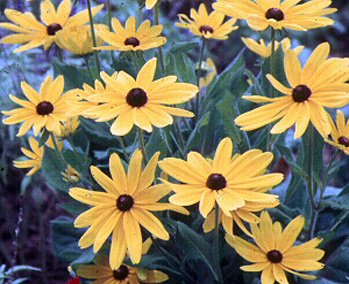Information Possibly Outdated
The information presented on this page was originally released on May 21, 2001. It may not be outdated, but please search our site for more current information. If you plan to quote or reference this information in a publication, please check with the Extension specialist or author before proceeding.
Rudbeckias are a must for gardeners
By Norman Winter
MSU Horticulturist
Central Mississippi Research & Extension Center
As you drive down Mississippi's highways and by-ways, don't lament that we don't fare well with blue bonnets, because this year our own wild phlox, coreopsis, Queen Anne's lace and Indian Pinks have been as pretty as a painting.
It won't be long until another of my favorite wildflowers advertises its landscape attributes to all who pass by. These are the black-eyed Susans. Their roadside performance should be a clear signal they will work in our yards, too.

Botanically speaking, black-eyed Susans are Rudbeckias. Rudbeckia hirta is native to Mississippi, and Indian Summer, a Mississippi Medallion winner, is of this variety. It was also an All-America Selections winner and recently won the Cut Flower of the Year Award by the American Specialty Cut Flower Growers Association.
Indian Summer is one gorgeous flower even if it is an annual. The plant reaches 42 inches in height and produces its heart out with large, softball-sized blooms. A mass planting of these combined with a mass of purple coneflowers will make your border look like you are the gardener of the year. Their site and care is fairly standard.
There are 30 to 40 other species of Rudbeckia native to the United States. One of my favorites is the Rudbeckia fulgida. The Goldstrum variety was the Louisiana Select Plant of the Year and a U.S. Perennial Plant of the Year.
The flowers are nearly as large as Indian Summer, but they bloom from May until the first hard frost and then return in the spring. The leaves are fairly large, oval and dark green. Keep well watered during droughts, and remove dead flower heads for maximum bloom. Most years, gardeners are rewarded with more flower stalks being produced in late summer or early fall.
I occasionally run across a gardener who thinks these are too aggressive and vigorous, but I feel passionately that these are among the best plants for any gardener-- beginner or expert.
Rudbeckia fulgida are great planted along sunny borders. I have combined them with the Biloxi Blue and the violet Tapien verbenas. They also work well with asters, goldenrods, homestead purple verbena, and liatris or gay feather.
The Rudbeckia triloba is another outstanding species for Mississippi. This is a Georgia Gold Medal winner, and it could qualify here as well. It is a prolific blooming perennial that is sometimes treated as an annual.
It has an abundance of yellow flowers with button-shaped black centers produced at the ends of many-branched stems. It is very erect, growing about 3 feet tall, spreading and bushy. The leaves are dark green and divided into three oval parts, hence the name triloba.
Rudbeckia triloba originated on the prairies of the United States. Plant in full sun in organic-rich beds. Promptly cut back flowers just as the bloom finishes to extend the plant's life, or let the seeds ripen and collect them.
Plant in the middle of the border with cosmos, zinnias or the new Angelmist angelonias called Summer Snapdragons. Be bold and create large drifts of color.
If you would like a Rudbeckia with a green eye, look no farther than Irish Eyes. This plant has a green cone and single flowers opening 4 to 5 inches across. With its foliage reaching about 30 inches tall, Irish Eyes are striking and unusual. They are grown as an annual or short-lived perennial.
If conditioned, black-eyed Susans are great cut flowers with a long vase life. The secret is to place a cardboard sheet on top of a deep pan containing 100 to 110 degree water. Cut holes in the cardboard to allow the stems to be placed through it and into the water. When the petals are flat and the stem straight, it is ready for the vase.
We can learn a lot from the roadside, especially when it comes to tough, beautiful flowers. Once we have learned this lesson, the next step is to take a trip to the garden center to get our own flowers.






